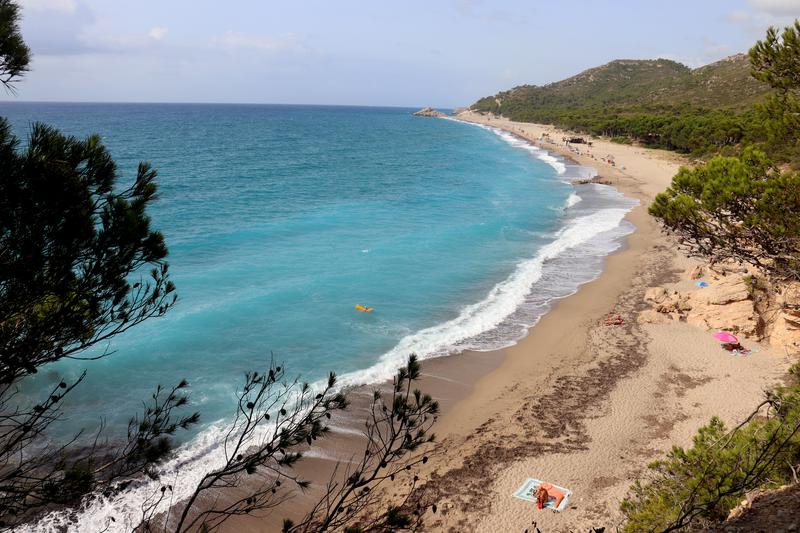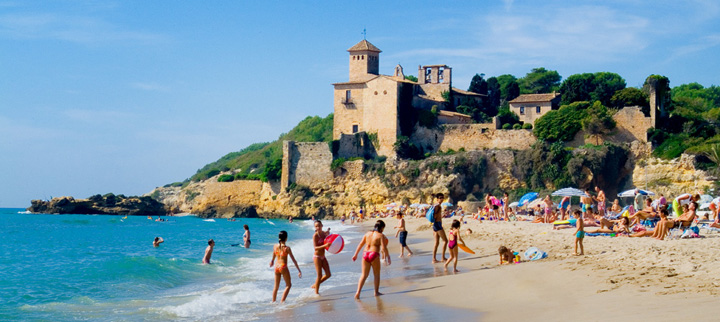Best beaches in Catalonia
From sunbathing to watersports, quaint old quarters to castles, Catalonia's 600km of coastline offers something for everyone

Catalonia has many excellent beaches along its almost 600 kilometers of coastline, and those looking for a bit of sea, sun and sand are spoilt for choice.
With its castles, cliff walks, and water sports, Catalan beaches offers the visitor much more than just sunbathing on the fine golden sand.
Coming up with a top 10 list of the best beaches in Catalonia is an almost impossible task, but below you will find our pick of some beaches along the coast that are worth a visit.
From north to south, Catalonia has four main coastal areas: Costa Brava, Costa Barcelona, Costa Daurada and Terres de l'Ebre. Below you'll find three beaches for each one.
Costa Brava
One of the most famous stretches of coastline in the world, Costa Brava (meaning 'wild' or 'rugged' coast in Catalan) stretches from the French border down to the seaside town of Blanes, some 60 km north of Barcelona. The original home of the package holiday, Costa Brava has everything you need to enjoy some time away. Apart from its good climate and excellent beaches, it also has areas of natural beauty, local festivals, museums, shopping, and top wineries and restaurants.
Port Lligat (Cadaqués)
Located in a small bay protected from the sea by the islet of Portlligat, beachgoers will find a tranquil spot to do some sunbathing. Surrounded by mountains and woodland, the gray pebbled beach is one of the local areas most charming spots, although it is not large and can fill up on busy days. Portlligat is also where surrealist artist Salvador Dalí spent his summers and nearby is the Casa Museu Salvador Dalí.
Portitxol (L'Escala)
In the municipality of L'Estartit, Portitxol beach is near to the Greek and Roman ruins of Empúries. With a backdrop of rugged cliffs dotted with pines, this sandy beach with shallow water is ideal for families. The beach also has facilities for people with reduced mobility.
Sa Tuna (Begur)
Located in Begur, the quiet, sandy Sa Tuna beach has its own small promenade with bars, restaurants and other local establishments. Around about are to be found residences that are typical of the Empordà region, with the docked fishing boats giving the area a picture postcard feel.
Costa Barcelona
As the name suggests, Costa Barcelona is the stretch of coastline centered around the Catalan capital. In fact, the Costa Barcelona brand was created in 2011 to bring together the various coastal towns near the capital, and it comprises 100 kilometers of coastline north and south of the city. Apart from being in easy reach of Barcelona itself, the area offers a wide range of other attractions, including natural parks, three of Catalonia's main winegrowing areas, and some of the best modernist architecture in the country.
Pont del Petroli (Badalona)
Just half an hour north of Barcelona, Badalona's Pont del Petroli beach is bordered by a maritime promenade in the city's Progrés neighborhood. Next to the beach is the Anís del Mono factory, which has been making its trademark anise-flavoured apéritif since 1868. The factory was declared a heritage site in 2007.
Mar Bella (Barcelona)
Of Barcelona's different beaches, Mar Bella is perhaps the most lively. Located in the Sant Martí neighborhood, it is 500 meters long and about 40 meters wide. As with the city's other beaches, Mar Bella is the result of the urban work carried out for the Olympic Games in 1992. The beach also has a nudist section, as well as a bar that is popular with the gay community on summer nights.
Garraf
Garraf beach is popularly known as Les casetes del Garraf, due to the green wooden shacks that were traditionally used by fishermen to store their equipment. The beach is 380 meters long and is made of fine sand mixed with small pebbles. It is also well-equipped with showers, toilets, places to rent sunshades, as well as a hotel and restaurant.
Costa Daurada
Offering some 60 fine sandy beaches, the Costa Daurada ('golden coast') stretches for over 80 kilometers between the towns of Cunit and Hospitalet de l’Infant, in the south. The seaside town of Salou is the area's main tourist center, and nearby is to be found the popular Port Aventura theme park. However, the Costa Daurada is also an area with a long history that goes back to the Greeks, and is home to some of Catalonia's most impressive medieval monasteries. It is also a major wine producing area and ideal for a spot of wine tourism.
Altafulla
The beach of Altafulla stretches between the Cap Gros and Roca del Gaià headlands. Situated in front of a promenade with small summer dwellings, it is one of the small town's key public meeting places. The beach itself boasts fine sand and calm waters. The town also has a quaint old quarter, which has been declared a UNESCO World Heritage Site.
Tamarit
Tamarit beach is overlooked by the imposing 16th century Tamarit Castle, which the Catalan government declared an asset of cultural interest in 1988. The fine sandy beach is a serene spot, with calm shallow water and bordered by vegetation. The 1.7 kilometer long beach is cleaned by hand every day.

Cala Fonda (Espai Natural de la Punta de la Mora)
Also known as Waikiki, the Cala Fonda beach is in one of the greenest parts of the Tarragona coast. A path passing through pine woods leads to the well-looked-after beach that is bordered by rugged cliffs. The sand is fine and the water is shallow and calm, and it is a quiet, relaxing spot where nudism is also allowed.
Terres de l'Ebre
Catalonia's southernmost coastal area, Terres de l'Ebre ('The Ebre Lands') takes its name from the River Ebre, the second-longest river on the Iberian Peninsula, which passes through the region and empties in a delta on the Mediterranean Sea, close to the town of Amposta in Tarragona province. A key feature of the region is its unique natural environment, and in fact it was declared a Biosphere Reserve by UNESCO in 2013, only one of two places in Catalonia to be awarded the distinction.
Fangar (Punta del Fangar)
Fangar beach is to the north of the delta into which the River Ebre empties. At 400 hectares, the beach has a desert-like feel to it, with fine sand and dunes. Yet, the beach is located in a completely natural area and lacks the usual services, such as showers and bars, which are these days provided on most beaches. It is an area that is also popular with seafood fishermen. As the beach is located in an area where the river and the sea meet, the sand has a muddy texture, which is where the beach gets its name ('fang' means mud in Catalan).
Cala Xelín (L'Ametlla de Mar)
The Cala Xelín cove is one of Terres de l’Ebre's most idyllic spots. The pebbled beach is surrounded by vegetation and gives on to fresh, crystalline water. The 120 meter long beach is located in the residential neighborhood of Tres Cales, has a shower, and can be reached either by car or on foot.
Riumar (Deltebre)
This extensive beach is in a natural area and is accessed by wooden boardwalks that pass through a cordon of sand dunes. Popular with kitesurfers, the wide-open, clean beach is ideal for watersports of all kinds. It is also perfect for families with small children, and there are a number of beach bars on the nearby promenade.
Nudist beaches
Nudism is allowed on a number of beaches in Catalonia, such as the aforementioned Mar Bella beach in the city of Barcelona. Below are a few more suggestions for those who like to let it all hang out.
Torn
Torn beach near the southern town of Hospitalet de l'Infant has a reputation for being one of the best nudist beaches in Spain. Some 1.6 kilometers long, the beach is located in a protected natural area and boasts the picturesque Torn islet, which used to be a watchtower guarding against pirates. There is also a large naturist campsite nearby.
Marquesa
The fine sandy Marquesa beach is located amid dunes on the Fangar peninsula. It is a kilometer long, around 100 meters wide, and has a restaurant nearby and parking, although like most beaches in the Delta de l'Ebre natural park it does not have any showers. The beach is just seven kilometers from the town of Deltebre.
Illa Roja
Between Begur and Pals, the shady Illa Roja cove is like a small oasis amid the area's coastal cliffs. It gets its name from the red rock islet facing the beach, which is surrounded by rock formations and pine trees. It is a quiet spot that nevertheless has international renown among nudist beaches.
Dog-friendly beaches
Most dogs love the beach, but not all beachgoers like dogs. That makes finding a beach where you can take your canine friend with you can be a challenge. Fortunately, there are a handful of beaches in Catalonia that tolerate or allow four-footed companions.
Cala del Cementiri
Located in Ametlla de Mar (Tarragona), Cala del Cementiri is a small cove without any showers, but where dogs are tolerated. The pebbled, 20-meter long beach is in a less populated area of Ametlla, but can be reached on foot or by car.
Cala Bon Caponet
Since 2012, the Ametlla de Mar council has allowed dogs at the Cala del Bon Caponet cove. Some 50 meters long, the pebbled beach is to be found in the residential neighborhood of Roques Daurades, half a kilometer outside the town center.
Cala Vallcarca
The Cala Vallcarca cove on the Garraf coastline has a small, sandy beach about 65 meters long that allows pets. Despite being somewhat isolated, it does have a beach bar. The cove can be found near the Uniland cement factory on the Barcelona-Calafell main road.
Rubina
Located in the natural surroundings of Empordá's Parc Natural dels Aiguamolls, Rubina beach is cleaned every day, has toilets and bars, as well as a lifeguard service. It is unusual in that it includes an area at the north end of the beach where dogs are allowed to swim in the sea. However, dogs are not allowed on the other parts of the beach.